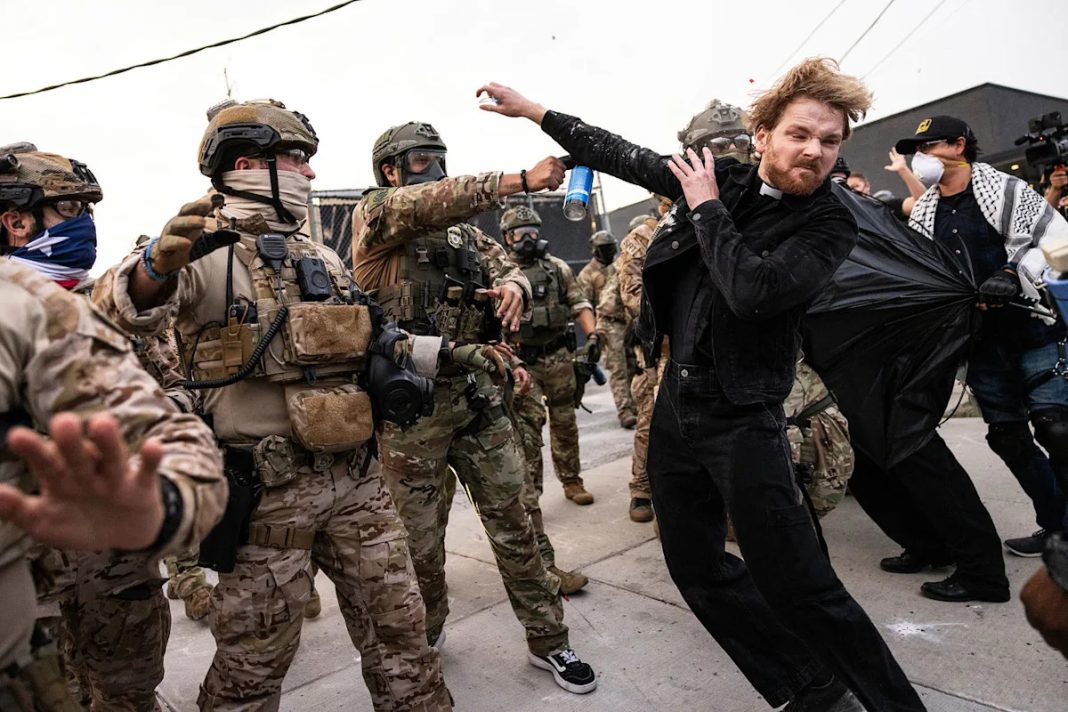The Trump White House has often cast itself as a defender of religious liberty. “America has always been a nation that believes in the power of prayer,” President Donald Trump said at a meeting of his Religious Liberty Commission last month. “And we will never apologize for our faith ever, ever, never, never. We will never surrender our God-given rights.”
Except, at least when Trump is speaking, “ever, ever, never, never” appears to have a limit: when the faithful dare to dissent from his political agenda. Time and again, we’ve seen that when faith leaders call out injustice and stand with the oppressed, Trump’s pledge of protection goes out the window.
In the Chicago suburb of Broadview, Illinois, clergy and other peaceful protesters have been gathering daily for more than a month to demand the humane treatment of detainees inside an ICE processing center. Federal forces deployed to the site responded with tear gas, flash grenades, rubber bullets and chemical weapons, according to a new lawsuit filed by the ACLU of Illinois and others. Now-viral videos show Pastor David Black of the First Presbyterian Church of Chicago being shot in the head with near-lethal projectiles and sprayed in the face with tear gas while he led a peaceful prayer and freely expressed his faith.
On Thursday, Black and his fellow plaintiffs won a temporary restraining order in federal court against Homeland Security Secretary Kristi Noem and other government officials to halt this heavy-handed assault on First Amendment rights. The order specifically bars the defendants from using riot control weapons against religious practitioners “who are not posing an immediate threat to the safety of a law enforcement officer or others.”
The lawsuit makes the case that the First Amendment rights of freedom of press, freedom of assembly and freedom of speech are all imperiled by the government’s actions, as are religious freedom rights. It states the government’s “policy, pattern, and practice of targeting Rev. Black and other similarly situated Religious Exercise subclass members with violence substantially burdens their exercise of religion. No compelling governmental interest exists that would justify Defendants’ use of force against clergy peacefully praying in public spaces, nor is the wanton and gratuitous violence employed by Defendants the least restrictive means of furthering any compelling governmental interests that might exist.”
This is not merely a confrontation over crowd control, immigration policy or policing tactics — it’s a deeper assault on faith-based dissent. The government’s response implicitly says that if faith communities protest, they will not be treated as legitimate religious actors. Rather than respect the sincerity of their beliefs, the administration’s posture is to strip them of religious legitimacy to justify suppressing their protected speech.
Tricia McLaughlin, a high-ranking Department of Homeland Security official, posted on X using quotation marks in reference to Black being a “pastor.” Black is, in fact, a pastor and was ordained in the largest Presbyterian denomination in the country.
This isn’t the first legal argument linking religious exercise and protest. My organization, Interfaith Alliance, partners with faith communities across the country that are engaged in the prophetic tradition of protest. We filed a friend-of-the-court brief in Newsom v. Trump, another case that deals with the Trump administration’s crackdown on dissent. “Americans of many faith traditions are called to protest, among other First Amendment activities, as an expression of their religious commitments to rectify injustice and pursue righteousness,” we argued. “That principle holds true broadly across many faith traditions practiced in the United States.”
Indeed, in Supreme Court precedents stretching over decades, religious liberty has never been confined to sanctuaries or private worship. It includes the public expression of conscience, from the Rev. Martin Luther King Jr. and civil rights marches to modern clergy advocating for immigrants, prisoners or the marginalized. The First Amendment does not have an asterisk saying that religious acts are only protected with government approval.
From the very first days of the Trump administration, when Trump and his allies attacked Episcopal Bishop Mariann Budde after she pleaded with him for mercy for immigrants and the LGBTQ community, they have made clear that religious liberty does not extend to their perceived enemies. They’ve attacked Catholic, Lutheran, Muslim and Jewish organizations that step out of line with their agenda.
The administration’s posture carries serious legal and civic risks. If the government can determine which religious actors are “real” and which are merely political dissidents, then it wields a dangerous tool for censorship. Clergy who align with the administration’s preferred causes may be protected; clergy who step outside those bounds can be silenced as troublemakers. That dynamic is antithetical to religious freedom.
The courts must resist that logic. Thankfully, Black and his fellow plaintiffs have won a temporary restraining order. That gives us hope that there will be more court victories that honor religious freedom for all Americans despite the Trump administration’s intolerance.
Let all prayers be heard. Let the dissent be defended. America’s commitment to religious freedom must extend not only to ideas and beliefs, but to the sacred right to protest.
This article was originally published on MSNBC.com

